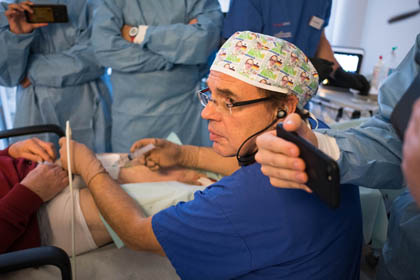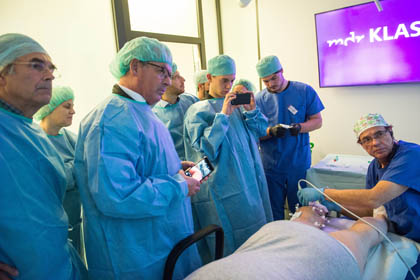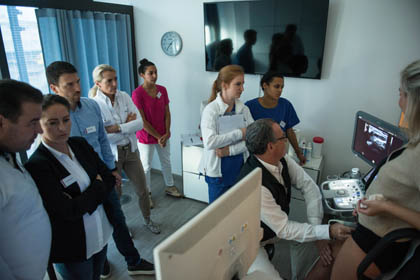Videos
In order to load videos, please click here and we open the same page with links and a data connection to youtube for you.
Film Compression Bandage
The film compression bandage is a new and unique modality to optimize the results of superficial foam sclerotherapy. Until modifications of the liners (layers required for storage and application of the film bandage) have not been fully performed according to dr. Ragg's patents, the application may be tricky if not unsatisfactory. This video shows how to use Tegaderm Roll (3M) to form a film compression bandage. May provide an impression of what it is about, but much too complex for daily use.
Temporary and persistent blood cell aggregates
When looking at vein valves with high-resolution (HR), broad-band ultrasound systems, blood particle aggregations appear more intense. While some echoes represent typical low-flow aggregates (calles "sludge"), others seem to be stationary or fixed, resisting any flow acceleration, e.g. due to calf compression, foot movements, walking simulation or even tough physical exercise. We call them "motion-resistant aggregates" (MRA). These aggregates are neither velocity dependent like sludge nor are thy thrombus, which would show blood platelet aggregates and fibrin mesh. Once you know MRA, you will find them very frequently. MRA possibly correlate with inflammatory cusp infiltrations which are known for long from histology.
Hemodynamics and thrombus formation
This video shows a HR ultrasound of a femorosaphenal junction. We happened to see this floating, egg-shaped thrombus. This video nicely explains the relationship between venous stasis and thrombus: Within this GSV, there is stasis when the patient is standing or sitting, and GSV reflux already due to inspiration. As the proximal GSV is the most distal segment to be flushed by foot pump and calf musscle pump, there is a zone of maximal stasis, while the junction is sufficiently flushed by reflux and inflow from the superficial inferior epigastric vein. Thrombus formation occurs always in the area of maximum stasis. By the way, this situation was cured within minutes with an interventional procedure (laser coagulation), including the whole diseased vein, discharging the patient happily after two hours, without any danger of embolism and oral anticoagulant for just three days.
Vein valve dysfunction due to blood cell aggregates
This video shows one aspect of motion resistant aggregates (MRA): Both sinus are completely filled by MRA. The cusps look complete and rather tender and could be misinterpreted as regular. But during any motion, the cusps do NOT MOVE! There is reflux because the cusps are fixed. Total or partial cusp fixation by MRA is one of several ways of valve dysfunction. We look on an initial stage of venous insufficiency, usually not detected in daily practice.
Another potential mechanism of acquired vein valve damage is inflammatory degeneration ("sinus phlebitis").
Asymmetric valve damage
This video shows the two cusps of a GSV valve in a 34 year old female patient: One cusp looks almost normal (preserved structure, fully mobile, but moderate sclerosis) while the other one is crippled, immobile and associated to immobile blood cell aggregates. A single look does not reveal the genesis of this particular pathology, but even a congenital cusp lesion has to be considered. Longitudinal studies will help to explain if blood cell aggregates induce valve damage, or valve damage (sclerosis, immobility) rather induces particle aggregation. From today´s view, the first of these mechanisms seems do be dominant.
Floating Thrombus in the saphenofemoral junction
Case report: A 5 year-old male patient (former general practicioner) presented for ultrasound examination with large varicose veins. Incidentally, a floating egg-shaped thrombus was found at the right SFJ. Thrombus size was 14 x 7 x 6 mm, located in a clearly refluxive vein of 9 to 16 mm Ø. Due to threatening embolism, the decision was to go for immediate treatment. What would have been your recommendation? When presented at the German Angiology Congress Berlin 2017, the audience voted 50% for surgery and 50% for conservative treatment. But there is no reason for additional injury (surgery) or any risk of embolism (bandage + anticoagulation). Read the poster and enjoy the outcome!
Novel Biomatrix Sclerofoam
Biomatrix sclerofoam is a new modality of non-tumescent ablation. The foam is based on denatured blood proteins, providing a viscous and stable foam. Therefore, injections are more precise and more effective than with Cabrera-type foams or Varithena. The simplicity of biomatrix sclerofoam application may be best explained for a simple task like this, where it is easy even for a non-expert to follow tools and foam in the ultrasound image: Refluxive GSV below the knee, due to perforator inflow at proximal medial lower gel, furthermore there is relevant sidebranch insuffiency. The GSV at the thigh had been ablated 12 years ago by 810 nm laser and is no more detectable. First, after local anesthesia a venous access is positioned (maybe microcatheter or catheter for larger tasks). One ml of whole blood is taken, at this time to undergo a laboratory procedure, in future a small foam generator will be attached to the catheter. Foam is injected under strict ultrasound monitoring. The ultrasound volume has to cover ALL the potential distribution area, deep veins inclusive! Within seconds, the biomatrix foam is properly placed within all targets, including perforator and side branch. If you will, the puncture channel may be closed with a cheap bare fiber, but that´s luxury. No bandage needed. Finished! Larger three-dimensional targets like big recurrent varicosities may require some more effort and experience, but may be treated according to the same principle.
This video refers to the poster presentation:




